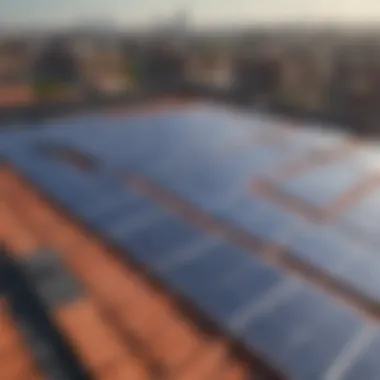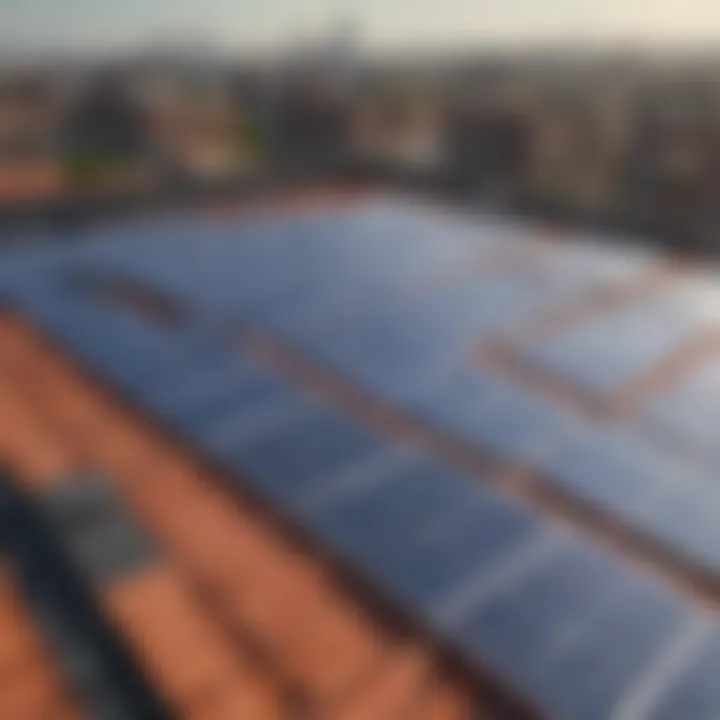Understanding the Average Cost of Solar Panel Installation


Intro
As the sun gleams down on your rooftop, one can’t help but wonder about the feasibility of solar energy. Beyond its environmental benefits, the financial implications of solar panel installation are a topic that's drawing attention from investors and homeowners alike. Exploring the average costs involved isn't just about dollars and cents; it’s a lens through which we can view the wider ecosystem of renewable energy. Understanding these costs sets the stage for making informed decisions that can significantly influence one’s financial future.
A number of factors come into play when considering the cost of solar panel installation. From what you're up against in local pricing to the ebb and flow of government incentives, each aspect contributes to your overall investment in this sustainable technology. Throughout this article, we will dissect the current landscape, offering insights into market behaviors and personal finance tips that can help you navigate this journey toward energy independence.
Market Insights
Current Trends and Developments
Many folks are jumping on the solar bandwagon. In recent times, the popularity of solar panels has surged due to a combination of technological advancements and a growing awareness of climate change. As installation processes become more streamlined and efficient, the average costs have begun to see a downward trend.
Local markets can vary significantly from one region to another. In sun-drenched states like California, residents often find themselves paying less, thanks to competitive pricing among installers. Conversely, regions with harsh weather patterns might see higher installation costs.
Market Analysis and Predictions
Looking ahead, analysts predict a continuous decline in costs, driven primarily by ongoing innovations in solar technology. Companies are pushing the envelope with better efficiency and lower production costs, which, in turn, lowers the installation prices. By being aware of the market dynamics, consumers might find themselves in a favorable position to negotiate better deals.
"The cost of solar technology is predicted to drop by another 30% over the next five years, making solar energy accessible for a wider audience."
Sector-Specific Insights
Venturing into niche markets, the commercial sector is also beginning to take strides in solar adoption. Businesses, especially in states with robust tax incentives, are finding it more financially viable to invest in solar. This sets a precedent that could inspire larger residential projects, as the notion of sustainability becomes woven into the fabric of everyday business decisions.
Economy Insights
Economic Indicators and Metrics
Economic climates play a crucial role in determining the cost of solar installation. Interest rates, for instance, can impact the financing options available to potential buyers. When rates are low, it's easier to secure favorable loans, making solar more attractive. Conversely, an uptick in interest rates can dampen enthusiasm.
Government Policies and Impacts
Government incentives are another piece of the puzzle that greatly influences pricing. Tax credits and rebates can significantly reduce out-of-pocket expenses, often rendering solar installation a no-brainer for many homeowners. These policies can vary by state and might change yearly, so keeping an eye on local regulations is essential.
Global Economic News
On a larger scale, global economic trends related to renewable energy can also sway consumer behavior. With rising oil prices, many individuals are now viewing solar energy as a more stable long-term investment, rather than a frivolous expense. This shift in mindset is already evident in markets across the globe.
Investment Strategies
Portfolio Diversification
Investing in solar isn't just about purchasing panels; it's also about strategic diversification. By incorporating renewable energy into your portfolio, you're not only supporting sustainability but also hedging against fluctuating traditional energy prices.
Risk Management Techniques
When looking at solar as an investment, one must assess risks such as the likelihood of changing regulations and technological advancements. Staying abreast of industry news and aligning your investments with government policies can help mitigate these risks.
Investment Evaluation Criteria
It's important to evaluate the potential return on investment (ROI) when considering solar. Factors like energy cost savings, available incentives, and increased property value should all play a role in your calculations.
Personal Finance Tips
Budgeting and Saving Strategies
When planning for solar panel installation, budgeting should be your starting point. Understanding your financial landscape will inform how much you can allocate for installation and what financing options might be suitable.
Retirement Planning Guidance
For those nearing retirement, investing in solar panels can be a wise move. It can reduce monthly expenses, allowing for more flexibility in budgeting during retirement years.
Debt Management Tips
If financing your solar panels through loans, ensure you have a solid plan to manage that debt. Interest rates and loan terms should be compared and analyzed carefully to avoid unnecessary financial strain.
Case Studies and Success Stories
Real-Life Practical Examples
Many homeowners and businesses that have installed solar panels report significant savings on energy bills. Take, for instance, a household in Arizona that cut their electricity costs by nearly 50% after making the switch to solar.
Successful Investment Stories
On a commercial scale, a local coffee shop integrating solar energy not only reduced its overhead costs but also marketed itself as a green establishment, drawing in environmentally conscious consumers who appreciate the shift toward sustainability.
Personal Finance Transformation Journeys
Countless stories demonstrate how investing in solar has transformed financial futures. From cutting energy expenses to increasing the valuation of property, the benefits can ripple far and wide beyond the immediate savings.
In a world where renewable energy options are more accessible than ever, understanding the costs and benefits associated with solar installation is crucial. By considering the factors we've discussed, you’ll be better positioned to make a well-informed decision and pave the way towards a sustainable — and financially sound — future.


Foreword to Solar Energy Installation Costs
When considering solar energy, understanding the installation costs is crucial. The upfront investment can seem daunting, yet it is usually offset by long-term savings and environmental benefits. Knowing what influences these costs lays the groundwork for wise financial decisions.
Importance of Understanding Installation Costs
Delving into installation costs reveals not just the immediate financial outlay, but also a spectrum of factors impacting the total expense. Without grasping these details, homeowners and investors might end up paying more than necessary. The knowledge of installation costs helps:
- Budgeting Accurately: Knowing estimated costs enables better planning.
- Making Informed Decisions: A detailed understanding aids in choosing the right installer and technology.
- Avoiding Surprises: Detailed insights minimize the risk of unforeseen expenses that can arise during installation.
In a world where energy choices are expanding, comprehending what goes into the cost of solar installation can act as your compass for navigating the solar landscape.
Overview of Solar Technology Advances
In the past couple of decades, solar technology has evolved tremendously, making systems more efficient and, importantly, often less expensive to install. New photovoltaic materials, like bifacial solar panels, can capture sunlight from both sides, thus enhancing energy output per panel.
Moreover, advances in manufacturing processes have driven down the costs of solar cells themselves.
These technology improvements mean:
- Higher Efficiency: Increased energy production per panel lowers overall system costs.
- Longer Lifespan: Enhanced durability means replacements are less frequent, improving the long-term investment.
- Wider Availability of Products: More options lead to competitive pricing in the market, making it accessible to a wider range of consumers.
Staying informed on these advancements not only helps consumers feel confident in their investment but also highlights the shifting landscape of renewable energy technology.
Defining Average Solar Installation Costs
Understanding average solar installation costs serves as a foundational aspect for anyone considering making the leap into solar energy. This component not only affects budgeting for a household or commercial property but also shapes the broader perception of solar energy's value. By grasping the nuances behind installation costs, potential investors can make informed choices that align with their financial and environmental goals.
What is Included in Installation Costs?
When diving into the realm of solar installation costs, one may find that it is not just about the panels themselves. Installation costs encompass a variety of elements, each playing a pivotal role in the overall financial layout. Here’s a breakdown of the aspects that typically factor into the costs:
- Solar Panels: The most substantial part of the installation cost. Different brands and material types can mean huge differences in price.
- Inverters: These crucial devices that convert direct current (DC) to alternating current (AC) typically add to initial expenses.
- Mounting Equipment: Depending on the roof or ground type, mounting systems can vary widely in terms of input.
- Electrical Components: Wiring, meters, and other parts essential to ensuring a functional solar system come into play here.
- Labor Costs: Expenses associated with labor can fluctuate depending on the region and complexity of the installation.
- Permitting Costs: Often overlooked, permits and inspections can significantly impact overall expenses, depending on local regulations.
Ensuring all these components are accounted for is crucial when estimating the actual out-of-pocket costs for solar installation.
Variations in Cost Estimations
Estimating the costs of solar installation is not a one-size-fits-all scenario; various factors contribute to dramatic differences in pricing. One of the main culprits is location. For instance, cities like San Francisco tend to have higher installation costs compared to rural areas due to various economic factors and demand for solar energy.
Additionally, the scale of the installation plays a vital role. A small home installation will have different cost parameters than a commercial-scale solar setup. Notably, the technology used also influences costs:
- Traditional solar panels are typically less expensive than cutting-edge bifacial modules, which capture sunlight on both sides.
- DIY installation efforts may save labor costs but incur expenses related to mistakes or lack of professional support.
"Relying solely on cost estimates from online calculators can lead to misunderstandings. Each project is unique."
Local incentives and financing options also trigger variations in final costs. Understanding these differences is critical for potential solar adopters. By recognizing the underlying factors and their implications on pricing, investors can better navigate their options and tailor their decisions to fit both budgetary constraints and energy needs.
Factors Influencing Solar Panel Installation Costs
When considering solar panel installations, numerous aspects come into play. Understanding the factors influencing costs is crucial for anyone planning to switch to renewable energy. Not only can these factors affect the initial investment, but they also shape the long-term financial benefits of harnessing solar energy. Knowledge about these elements aids consumers and investors alike in making informed decisions.
Type of Solar Panels Duplicating Costs
The choice of solar panel type is a major determinant of installation costs. Different solar technologies, like monocrystalline, polycrystalline, and thin-film, have varying price points and efficiency levels. Monocrystalline panels, known for their sleek design and high efficiency, often come with a heftier price tag, while polycrystalline panels offer a balanced option between cost and efficiency.
Some homeowners might opt for thin-film solar panels, which are less expensive but generally have a lower efficiency. Therefore, the choice of solar panel not only affects the initial investment but can also influence long-term returns. Furthermore, each type comes with unique warranties and durability, impacting future replacements or upgrades.
"Invest in quality panels now, or you might pay for it later with higher replacements!"
Installation Complexity and Site Preparations
The specific conditions of the installation site can heavily influence costs. Factors such as roof pitch, size, and orientation play key roles. For example, a steep roof may require additional safety measures and equipment, which can bump up labor costs. In contrast, a flat roof might simplify installation.
Additionally, if the installation involves any kind of structural upgrades, such as reinforcing the roof to hold the weight of the panels, expect those expenses to accumulate. Also, whether the system is connected to the grid can create extra costs such as permits or interconnection fees.
Consideration of the local environment is critical as well. Areas prone to strong winds or heavy snowfall could necessitate specialized mounting systems, ensuring the panels remain securely in place over their lifespan.
The Role of Labor and Geographic Variations
Labor costs constitute a significant portion of overall installation expenses. The average wage for skilled solar installers can fluctuate greatly depending on the location. In metropolitan areas or regions with high demand for solar, you might find labor rates to be higher. Conversely, smaller towns or rural areas could present more competitive rates.
Besides labor rates, local regulations and codes can influence the total cost as well. Areas with strict building codes may necessitate more extensive paperwork and inspections, which can lead to added costs.
Moreover, geographic factors influence everything, from the amount of sunlight received to the ease of access for installation crews. As much as 40% of the overall cost can derive from local labor and logistics, making this aspect one that should not be overlooked in planning.
Understanding these three factors - the type of panels, installation complexities, and labor costs - can offer a clearer picture of what to expect when looking into solar energy. So, it's definitely worth putting on your thinking cap when deciding to invest in solar panels.
Regional Differences in Installation Costs
Diving into regional differences in solar panel installation costs is crucial because these disparities can significantly affect the overall affordability and viability of investing in solar energy. Local climates, electricity rates, and the presence of solar incentives won’t just shape how much you pay initially; they can also influence your long-term savings and the environmental impact of your system. For investors and consumers alike, understanding where these variances lie can lead to smarter, cost-effective decisions.
Cost Comparison Across Different States


When considering solar panel installation, it’s important to note that costs can vary dramatically from state to state. For instance, the average cost per watt in California is considerably lower compared to states like Alaska or West Virginia. Why's that? A handful of factors come into play:
- Market Competition: States with many solar providers, such as those in the Southwest, tend to have better pricing due to competitive bidding. More companies often means better prices for consumers.
- Incentives and Rebates: States like New York and Massachusetts have robust rebate programs, driving down out-of-pocket expenses for homeowners. In contrast, states with limited or no incentives can see installation costs skyrocket.
- Labor Costs: The price of labor greatly fluctuates by region. Urban areas, while having more installers, may also have higher wage demands compared to rural areas.
- Installation Complexity: Certain regions might have stricter building codes or environmental regulations, making installations more complicated and, hence, more costly.
In summary, prospective solar buyers should compare the cost per watt in their state against others, weighing factors like local incentives and market saturation.
Influence of State Policies and Incentives
State policies and incentives play a pivotal role in shaping solar panel installation costs. Understanding these influences can empower users to take full advantage of available resources and potentially lower their expenses significantly. In the U.S., a mix of federal and state programs offers various incentives that are designed to encourage solar adoption. Key points include:
- Tax Credits: The federal solar tax credit allows prices to be reduced by a significant percentage. If states supplement this with their own tax credits, the savings can stack up quickly.
- Net Metering Policies: Some states offer net metering where excess energy produced by solar panels can be sold back to the grid. This financial return can reduce overall costs and improve ROI.
- State Grant Programs: In addition to tax incentives, several states provide grants or rebates that can offset up to a portion of installation costs. Understanding eligibility for these programs can lead to substantial savings.
- Regulatory Environment: Diverse policies regarding renewable energy can set a tone for solar investment. States with strong renewable portfolio standards typically see an uptick in utility-scale solar projects, influencing installation costs for residential setups as well.
Ultimately, potential solar customers should research and leverage both state and federal incentives tailored for their specific region. Each state presents a unique landscape for solar energy adoption, revealing opportunities that savvy investors must tap into.
Financing Options for Solar Panel Installations
When considering the transition to solar energy, understanding financing options is crucial. Financing options for solar panel installations can make a significant difference in the affordability and accessibility of renewable energy systems. With the rising costs associated with installations, not everyone has the luxury of paying upfront. Consequently, exploring various financing strategies can help potential customers make informed decisions.
Upfront Payments vs. Financing Plans
The debate between paying for installation upfront or utilizing a financing plan is a pivotal one for investors and homeowners alike. Here’s a look at both scenarios:
- Upfront Payments: Making an outright purchase can seem daunting initially due to high costs. Nevertheless, it often leads to substantial savings over the long haul. Owning the system outright means that you will not have monthly payments or accrued interest. Additional benefits also include eligibility for certain tax credits, such as the federal solar tax credit, which allows homeowners to reclaim a portion of their expenditure. For example, if you can pay $20,000 upfront, you can expect to receive a tax credit of 26% in 2022. This will save you about $5,200 in taxes.
- Financing Plans: On the other hand, financing plans can help alleviate that burden. Solar loans come with lower monthly payments, making sustainable energy more achievable for many. Besides, there are various financing models available:
- Solar Loans: These allow consumers to borrow money specifically for solar installation and often come with reasonable interest rates. The monthly payments may be offset by energy savings, meaning consumers could see little to no increase in their overall monthly costs.
- Power Purchase Agreements (PPAs): Under this model, homeowners pay for the energy generated by the solar system instead of purchasing the system itself. It's often a good choice for those who want solar energy without the upfront costs, though long-term costs may end up being higher than direct ownership.
Ultimately, the choice boils down to personal financial situations and goals. Carefully evaluating your current situation and how solar financing fits can help ensure you nab the best option.
Understanding Solar Loans and Leases
Solar loans and leases are two financing options that are gaining traction among consumers. Understanding the differences can help one navigate the landscape more effectively.
- Solar Loans: These loans specifically cater to financing solar panel installations. Generally, they allow homeowners to retain ownership of the system, thus maximizing potential savings. Loans can be secured or unsecured; secured loans often boast lower interest rates. Additionally, some banks and credit unions have tailored offerings for solar financing, making it easier to incorporate these into your budget.
- Leases: A solar lease is another popular option, wherein the homeowner pays a fixed monthly fee to use the system installed by a solar provider. While this often requires little to no upfront costs, it may limit long-term financial growth. For example, you may be paying $100 monthly for electricity through the lease, while owning the system might have allowed you to save significantly after the initial investment.
Ultimately, understanding the nuances of these options allows consumers to align their energy goals with their financial strategies efficiently.
"Investing in solar energy not only benefits the environment but can also yield financial rewards in years to come."
By closely considering all financing avenues, one can work towards choosing a solution that aligns with both environmental goals and financial capabilities.
Incentives and Rebates Reducing Overall Costs
When considering the financial aspects of solar panel installation, incentives and rebates play a critical role in shaping the overall costs. Many homeowners may find themselves overwhelmed by the initial investment required to install solar panels; however, understanding the various incentives and rebates can significantly alleviate these concerns.
These initiatives not only lower the installation costs but also enhance the overall appeal of adopting solar energy. In essence, the combination of federal, state, and local incentives creates a landscape where solar investments become increasingly accessible to the average consumer.
Moreover, with a growing movement towards renewable energy, these plans underline the government's commitment to fostering sustainable practices. Hence, taking advantage of available incentives is not merely wise but can also be seen as a socially responsible decision.
Federal Tax Incentives for Solar Installation
One of the most prominent financial benefits available to solar panel buyers in the United States is the Federal Solar Investment Tax Credit (ITC). This program allows taxpayers to deduct a substantial percentage of the installation costs from their federal taxes. Currently, the ITC covers 26% of the entire installation cost until 2022, gradually phasing down to 22% in 2023.
The appeal of this incentive cannot be understated, as it provides immediate financial relief during tax season. For example, if a homeowner spends $20,000 on solar panel installation, they could potentially receive a tax credit of $5,200 the following tax year, reducing the net cost significantly. While the tax credit alone is a major motivator, other benefits like increased home value become an attractive Consideration too.
Consider this to highlight the importance of leveraging such incentives:
"The true cost of solar energy isn't just the sticker price—it's also about the savings you'll reap along the way."
State-Specific Rebate Programs
In addition to federal programs, many states offer their own rebate programs designed to further reduce the costs of installing solar panels. These programs vary significantly by state, making local research essential for prospective solar buyers. Some states, like California, lead the charge with generous rebate programs, capable of shaving thousands off the upfront costs. Other places may offer performance-based incentives, which reward the homeowner based on the actual energy produced by their solar panels.
For instance, New York has adopted a program known as the NY-Sun initiative, which provides significant financial assistance, allowing residents to save on installation costs. Meanwhile, states like Texas might offer different forms of tax exemptions to encourage solar usage, as seen with their property tax exemption for solar installations.
Understanding the local landscape of available rebates not only empowers potential buyers but also can greatly influence the decision to adopt solar energy solutions. To navigate this maze, one could utilize resources such as Wikipedia or community discussions on platforms like Reddit to find up-to-date information and shared experiences from others tackling the same financial choices.
As we forge ahead in a world increasingly governed by concern for the environment and energy efficiency, understanding these incentives will illuminate the financial pathways that lead to renewable energy options.
Long-Term Financial Benefits of Solar Investments
Understanding the long-term financial benefits of solar investments is crucial for anyone contemplating the switch to solar energy. The initial cost of installation can seem quite daunting, but the savings and potential returns over time can make the transition worthwhile. This section aims to shed light on how investing in solar panels not only contributes to a greener planet but also makes good economic sense.
Calculating Return on Investment (ROI)
Return on Investment, often abbreviated as ROI, is a pivotal metric for assessing the financial viability of solar panel systems. In simple terms, it measures the gain or loss generated relative to the amount invested. To calculate ROI for solar installations, consider the following elements:
- Total Installation Costs: This includes hardware, labor, permits, and any additional setup expenses.
- Annual Savings on Utility Bills: One of the greatest benefits of solar power is the reduction in energy bills. How much you save will depend on your location, energy usage, and the size of your system.
- Incentives and Rebates: Don't forget to include any tax credits or state-specific programs that can offset your overall expenses. In the U.S., for example, the federal solar tax credit can reduce the upfront cost significantly.
- Energy Generated: Calculate how much energy your panels will produce over their lifespan, typically around twenty to thirty years. This will give you a clearer understanding of how much money you save over time.
"Investing in solar power is not just an environmental decision; it's a financial strategy that could yield considerable returns."
Once you have these figures, calculating ROI becomes straightforward:
This formula allows you to see the percentage return on your solar investment. A positive ROI indicates that solar panels are not only cost-effective, they are also a sensible long-term investment.


Energy Savings Over Time
The long-term savings on energy bills is where the true financial benefits of solar investments become apparent. After the initial setup costs, solar panels can significantly cut, or even eliminate, your electricity expenses. Here’s how energy savings evolve over time:
- Initial Savings: Right after installation, you will notice immediate reductions on your monthly utility bills. Depending on regional electricity rates, this can be substantial.
- Escalating Benefits: As energy prices rise, which they often do, the savings from solar become even more pronounced. You're protected, in a sense, from fluctuating energy costs because your own power source is the sun.
- Long-Term Impact: Over a span of twenty years or more, the cumulative savings can amount to tens of thousands of dollars. According to some estimates, homeowners can save anywherebetween $10,000 to $30,000 or more, depending on usage and location.
- Increased Property Value: Homebuyers are becoming more aware of energy efficiency and sustainability. Properties outfitted with solar panels can fetch higher prices on the market, as potential buyers see the value in lower utility bills.
Potential Challenges and Misconceptions
Understanding the dynamics surrounding the installation of solar panels can be akin to navigating a maze. The jargon, the varying costs, and mixed information can create a cloud of confusion. In this section, we delve into potential challenges and misconceptions that investors and consumers may encounter when considering solar energy. It's essential to unpack these misunderstandings, as they can influence decisions and ultimately, one's willingness to invest in solar technology.
Common Misunderstandings About Costs
Many people believe that solar panel installation is a black-and-white equation. One common misunderstanding is that the advertised costs reflect the total investment and savings. However, it’s crucial to note that installation costs can include a wide range of factors.
- Hidden Costs: While the average cost might imply a straightforward figure, not including permits, maintenance fees, and equipment upgrades might lead to unexpected expenses.
- Quality vs. Price: Some individuals might think that choosing the cheapest option is the most cost-effective; however, lower-priced panels can lead to higher costs down the line if they are less efficient or less durable.
"Investing in solar is not just about the price tag; it's about the value proposition in terms of longevity and energy savings over time."
- Incentives Overlooked: Many forget to factor in available financial incentives which can significantly offset installation costs. Federal and state incentives can help reduce overall expenses, making solar a more attainable investment than it initially appears.
Addressing Concerns About Cost Efficiency
Cost efficiency is often a fine line between perception and reality. When examining whether solar panels are a worthwhile investment, various factors come into play.
- Initial investment vs. long-term savings: Many hesitate to invest due to high upfront costs without considering the long-term savings that outweigh initial expenditures. The average payback period for solar panels typically spans 5 to 10 years.
- Energy Independence: Some challenge the efficiency based on fluctuating energy prices but overlook that solar offers a degree of energy independence. When energy prices rise, those with solar panels are often less impacted, which can result in stabilizing their long-term energy costs.
- Technological Advances: Technology in solar energy is improving rapidly, making panels more efficient and affordable over time. This constant evolution can discourage those who are grappling with old information, presenting a skewed view of cost efficiency.
In summary, it’s vital that prospective investors and consumers get beyond the hurdles of cost misconceptions. Grasping the true financial layouts and long-term benefits can empower better decision-making in the renewable energy landscape.
Future Trends in Solar Panel Installation Costs
Understanding future trends in solar panel installation costs is crucial for both investors and consumers. As technology continues to improve and market dynamics shift, the financial landscape surrounding solar energy is evolving rapidly. For homeowners and businesses considering the switch to solar, being aware of these trends can guide decision-making and interfere with long-term planning. Potential cost reductions and updated incentives drive the push towards greener solutions, making it essential to keep an eye on emerging developments.
Emerging Technologies Driving Prices Down
The advancement of technology plays a pivotal role in reducing installation costs. New materials and manufacturing methods have significantly enhanced the efficiency of solar panels, allowing them to generate more electricity per square meter. For instance, bifacial solar panels, which capture sunlight from both sides, have gained traction. These panels not only produce more energy but can often be installed with fewer units, leading to lower overall costs.
Additionally, automated manufacturing processes have made solar panels cheaper to produce. Machines and robotics in the production line minimize human error and reduce labor costs, allowing manufacturers to pass on savings to consumers. Moreover, the integration of smart technology, like AI-driven energy management systems, helps optimize energy use in real-time, ultimately improving efficiency and lowering utility bills.
"Investing in solar technology is no longer just about the initial cost, it’s about maximizing energy yield for the future."
These innovations not only lower installation prices but also enhance long-term value for those investing in solar energy. As adoption grows, economies of scale kick in, further reducing costs. This trend makes solar energy increasingly appealing as a viable financial option for many households and enterprises.
Predicting Future Market Dynamics
Looking ahead, several factors will shape the market for solar panel installation. Economic uncertainties can affect material costs, but a key factor to consider is the political landscape. Government policies, especially those aimed at promoting renewable energy, hold significant weight. For instance, if incentives continue or increase, we may see a surge in installations which can spread the costs thin.
The global push towards sustainability and reducing carbon footprints is driving innovation and investment in the solar sector. This creates a positive feedback loop. As more companies enter the market, competition increases, potentially driving prices down further.
Additionally, international trade policies can either facilitate or hinder access to technology and materials necessary for solar panel production. Tariffs and trade agreements significantly impact pricing. For example, favorable relationships with solar manufacturers overseas might lower costs, but tensions could lead to the opposite.
Unpredictable variables such as these make the market dynamics fluid and necessitate ongoing research and adjustments. By keeping abreast of changing trends in solar technology and legislation, consumers can make informed decisions, optimizing both savings and investment value in the long run.
Ultimately, understanding these trends might mean the difference between jumping on board the solar wave at the right time or missing out on significant savings.
Closure: Making Informed Choices
As we wrap up this exploration on the financial aspects of solar panel installation, the stress on making informed choices can't be overstated. Every potential solar investor, whether a homeowner or a business, should take the time to thoroughly assess their options. The journey into solar energy is not just a switch to renewable power; it's a substantial investment that requires a thoughtful approach.
Understanding your personal energy needs is the cornerstone of this decision. This helps in determining the right solar system size, the number of panels needed, and the implication it has on your overall energy bills. A well-calibrated choice will lead to not only effective energy usage but also substantial savings over time. Moreover, it positions you in a stronger spot when negotiating with installation companies.
It's equally crucial to evaluate various installation options. Different companies will provide differing prices, warranties, and service levels. By comparing these aspects, one can uncover options that may offer better savings or favorable terms, making the whole solar endeavor a no-brainer.
"Understanding your energy needs and available options not only ensures financial prudence but also empowers you in the decision-making process."
Key elements to consider include:
- Type of Solar Technology: Research the differences between monocrystalline, polycrystalline, and thin-film panels.
- Installation Prerequisites: Determine the necessary structural adjustments to your roof or property.
- Financing Choices: Explore both upfront and financing strategies to better align your investment with cash flow availability.
- Local Incentives: Check for state and local programs that could cushion your initial investment, making it more accessible.
Ultimately, making an informed choice means aligning your options with your unique circumstances, future plans, and environmental values. With the right information in hand, you're not just investing in solar panels—you're making a leap towards energy independence and sustainability for years to come.
Assessing Personal Energy Needs
When considering a solar installation, the first step is to tailor your approach based on your energy requirements. Begin by evaluating your current energy consumption. Reviewing past utility bills can provide insights into your monthly and seasonal energy usage—they're like a crystal ball reflecting your energy habits.
Armed with this data, you will want to determine how much of that load you’d like to offset with solar energy. Here are some vital factors to consider:
- Home Size: Larger homes typically consume more energy. Understanding this helps in estimating how many panels will suffice.
- Energy Efficiency: If your home has energy-efficient appliances, you may need fewer panels compared to standard appliances.
- Usage Patterns: Knowing when you use energy the most can inform whether battery storage or grid independence is necessary.
To sum it up, a correct assessment of your energy needs isn't just a requirement, it's a pivotal step that shapes the rest of your solar journey.
Evaluating Installation Options for Better Savings
The market for solar installations isn’t a one-size-fits-all scenario. Options are aplenty, but digging deeper into the details can lead to more savings. Start by gathering quotes from multiple installers, being mindful of the scope of services, warranties offered, and customer reviews.
Some particular areas to look into include:
- Licensing and Certification: Ensure the installers are licensed and certified. This not only ensures quality work but may have financial implications in case of warranty claims.
- Warranty Terms: What guarantees are provided? A solid warranty can save you headaches—and cash—if a panel underperforms.
- Customer Feedback: Dive into reviews and even seek out local forums, like those on Reddit. Real experiences and insight from other users can illuminate the pros and cons of different companies.
Incorporating these considerations can convert what may seem like a daunting process into a series of straightforward decisions, guiding you towards a solar installation that maximizes both efficiency and your financial outlay. By evaluating options with an eye for value, you're setting the stage for substantial long-term savings.



